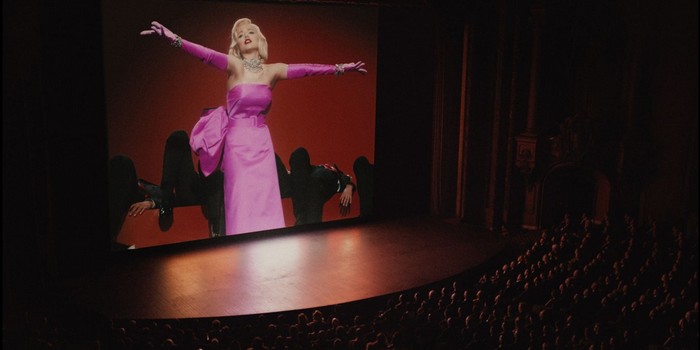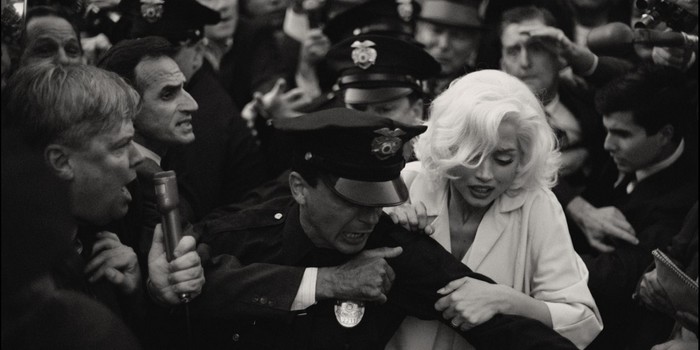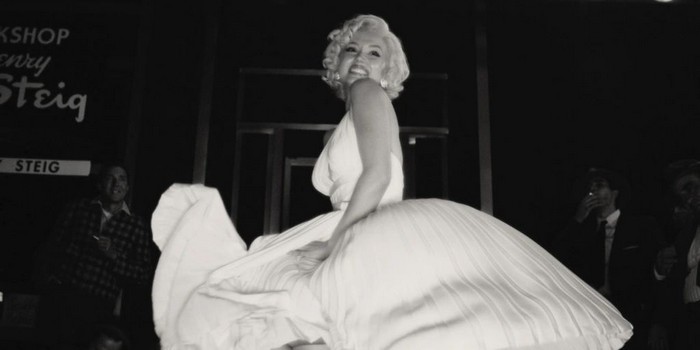In project for several years, Blonde hair by Andrew Dominik (The Assassination of Jesse James by the Coward Robert Ford) is finally coming to Netflix. Initially presented at the Venice Film Festival and preceded by a sulphurous aura, this faux-biopic of Marilyn Monroe worn by Ana de Armas is eyeing much more on the side of the psychological horror film than the autobiographical story. A real slap!
Andrew Dominik has more than 20 years of career, and yet he is only in his 4e feature film with Blonde. Proof of a demanding filmmaker with no less singular projects, including the latest film (Cogan: Killing Them Softly) is already ten years old. The New Zealander cut his teeth above all with the biopic (chopper) and the revisionist western (The Assassination of Jesse James by the Coward Robert Ford).
In these two projects, Dominik approached two figures who really existed (one contemporary, the other not) by diverting the codes of their respective genres. It is therefore no coincidence that he tackles the adaptation of the novel Blonde hair by Joyce Carol Oates, published in 2001 (and having already been transposed into a mini-series). Contemporary novelist of Marilyn Monroe, the latter gives birth toa fictional biography, transcribing the inner, poetic and spiritual life of Norma Jeane Baker, battling behind the spotlight with her famous Hollywood alter-ego.
Falling in love with the book, Andrew Dominik tries for more than 10 years to make an ambitious film adaptation (initially with Naomi Watts then Jessica Chastain), whose simple profession of faith will be enough to generate rejection towards certain spectators. Because Blonde does not ultimately have so much to do with the biopic genre as with pure horror film and psychological dramawith as a simple (and fascinating) basic premise a total dissection of the 20th century icon dubbed the “Dumb Blonde”.
Who’s your Daddy now?
Opening with iconic images of Marilyn Monroe on the set of Seven years of reflection (the dress rising on the air vent), the story begins after the title of the film, inviting us to discover the traumatic childhood of Norma Jeane Baker. Presented to the supposed portrait of her biological father (in the physique of Cary Grant), the young Norma will see her childhood turned upside down by the loss of her psychotic mother (interned in a psychiatric asylum and plunged deeper into madness over the years), having tried to kill her, then by the perpetual search for the father figure (materialized by the unique sequences in color, according to her encounters with men of his life)
Thereby, the film takes head-on the figure of a virginal little girl (calling her lovers “daddy”) erected as a Hollywood pin-up. Considered a sex symbol and an object of desire by men, Marilyn Monroe has regularly been condemned to her image of a slightly nunuch blonde, zieutée above all for her plastic than for her talents. Since then, Blonde takes a completely disenchanted (even miserable) look at an entire industry and an era that will have transformed Norma Jeane.

Thus, from her acting debut in 1952 after modeling, until her death in 1962, the film connects the slices of life with large ellipses, like a mental puzzle inviting us into the other side (or rather hell) of the decor. Raped by vile producers, beaten by her husband Joe DiMaggio, desperate to have a child, sinking little by little into despair, alcohol and barbiturates… the story borrows well-known segments of her life while by extrapolating some, see by plunging the feet together in the era allegations that Marilyn and John F. Kennedy were having an affair (in a scene that is sure to cause controversy).
Masterpiece of staging
A sort of psychological and romanticized dive, Blonde gradually turns into a missing link Mulholland Drive or even Repulsionas the footage goes further and further into the nightmare. This is the whole point and the wonderful intention of Andrew Dominik’s film, which is not so much a painting of Marilyn Monroe but a story of ghosts and trauma, having completely dissociated the identity of a young woman in search benchmarks and real recognition.
It takes about a few seconds for Blonde to immediately show that yes, Andrew Dominik has indeed spent 10 years developing his film: each shot is stunningly beautiful despite the increasingly dark darkness. The sumptuous photography of Chayse Irving showers us with shots in immaculate black and white, while Dominik’s sensory realization then switches to esotericism via an increasingly sophisticated staging.

Changes in ratio, colorimetry, or quite striking reconstructions of the period and of filming (the craziest remains that of Some like it hot), the camera comes up with some crazy ideaslike sequences of talking fetuses that David Lynch would not have denied (including an intra-uterine subjective shot), or even a sulphurous sequence of threesomes filmed as a transcendental experience. The most telling (and yet the one that most simply illustrates the film) is the one where Norma Jeane, in tears in front of her mirror, changes like a possessed Marilyn Monroe, all smiles shining out !
Norma de Armas
Among all this constellation of talent, including Bobby Cannavale, Adrien Brody, Julianne Nicholson…there is of course the brightest star: Ana de Armas (Knives Out, Dying can wait). Sensational in each scene, the actress delivers here her very best performance, in a true mimicry of Marilyn Monroe during the famous cult sequences of the icon, while completely appropriating Norma Jeane to make her a moving cinema character.
Whether it’s during an emotional casting sequence, a heartbreaking fall on the beach or the desperate wanderings close to a certain schizophrenia, we easily hold one of the performances of the year. Combined with the talent of Andrew Dominik, all it takes is a few piano notes anda magnificent evanescent score by Nick Cave & Warren Ellis to touch grace.

We could dissect more deeply Blonde hairor even question the fact that the story evades many key pieces of Monroe’s life (the moments of joy are present, sparingly though), but Andrew Dominik gives birth to a story like no other. The story of a woman of talent, passion and generosity. And its media double, shaped by tragedy, glitter and misogyny. A movie slap, a real one !
Blonde will be available on Netflix on September 28, 2022
notice
9.5
Blonde is a rare and precious film. Andrew Dominik revisits the myth of Marylin Monroe to deliver a pure psychodrama of horror, where fiction augments reality, and where reality nourishes reverie as much as nightmare. Driven by the most sophisticated manufacturing as much as by an immense performance by Ana de Armas, Blonde is clearly not going to finish fueling the passionate debates. Simply the mark of a great film!

